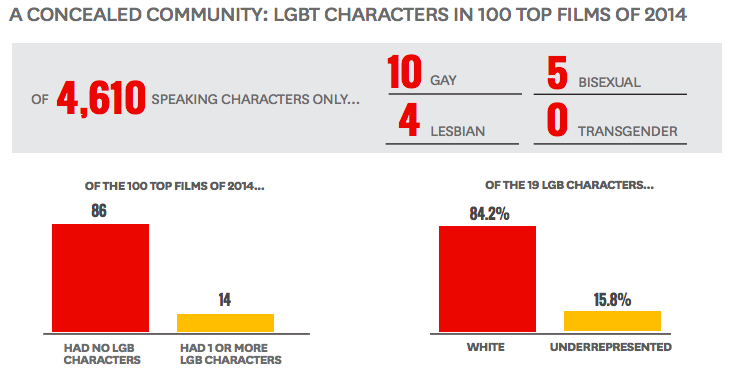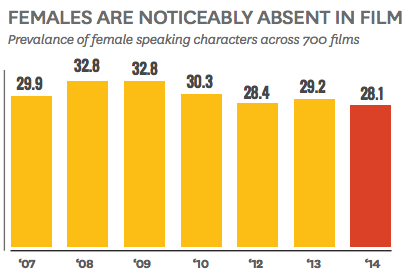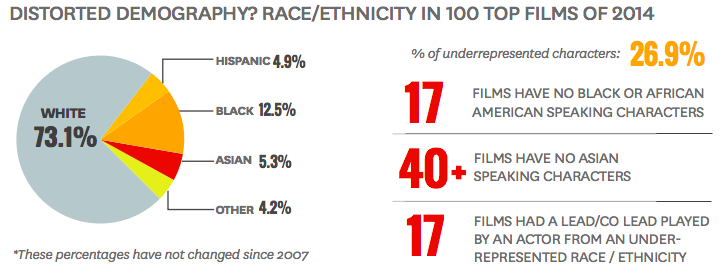One Group Had Literally Zero Representation in 2014's Top 100 Movies at the Box Office

By:
"The landscape of popular cinema in 2014 remains skewed and stereotypical," according to new research. For gay, lesbian, bisexual, and transgender people, the plight of Hollywood discrimination is especially obvious. The top 100 blockbusters of 2014 included a total of 4,610 speaking characters. Nineteen of those were LGB; not one of them was T, which is to say that transgender individuals were effectively snubbed, with zero representation in the film industry last year.
This research comes from the Media, Diversity & Social Change Initiative at the University of Southern California’s Annenberg School for Communication and Journalism. Dr. Stacy Smith and her team looked at 700 films—the 100 top-grossing films of each year from 2007 to 2014—and found that women, LGBT individuals, and racial minorities were, as usual, underrepresented in Hollywood.
That bears repeating: Not a single transgender character was depicted in Hollywood last year.
"I really think we’re seeing an epidemic of invisibility across multiple groups," Dr. Smith, the lead researcher of the Annenberg study told ATTN:. "So with the transgendered community, we’re not seeing those stories reflected on screen."
I asked why this might be, and while Smith and the study's co-author, Dr. Katherine Pieper, felt that there was not a "one size fits all" explanation for Hollywood's diversity issues, there are some research-backed theories. For example, in a study published the April, they found that more than 40 percent of the 100+ industry leaders they interviewed said that features that appeal to men—"male leads, male stars, male casts, tentpoles, comic book-driven content"—succeeded at the box office.
"What we found is that the industry decision makers really hold on to an ideology of the gendered marketplace—this idea that the profitable side of the marketplace is male-oriented and male-driven," Pieper added.
 USC - usc.edu
USC - usc.edu
It is a common complaint among film buffs and industry critics—that Hollywood skews white and male—but to quantify the racial and gender disparities adds weight to those complaints, exposing the latent biases of the motion picture business.
Of the 30,835 speaking characters evaluated from the 700 top-performing films between 2007 and 2014, only 30.2 percent were women. The gender ratio of the 21st century is, therefore, a regrettable 2.3 to one. What's more, only 21 of the top 100 films of 2014 featured a female lead (or roughly equal co-lead). That's down from the previous year when 28 female stars made the cut, but it's consistent with results from 2007, when the researchers first started this longitudinal study and determined that female leads represented just 20 percent of the top 100 movies.
 USC - usc.edu
USC - usc.edu
In terms of racial representation in Hollywood—well, things don't look any better. Take the top 100 films, for example. Though the film industry continually insists that it does not discriminate against minorities, the numbers beg to differ. No less than 73.1 percent of speaking characters in the top 100 were white last year. Only 12.5 percent of the more than 4,000 roles were played by Black people; only 5.3 percent were Asian; and only 4.9 percent were Hispanic.
 USC - usc.edu
USC - usc.edu
"Because there's so much money on the line—it can take $100 million (including marketing costs) to get a hit studio film off the ground—there's an extreme reluctance to take chances when it comes to casting and choosing directors," LA Weekly reported. "A white man can seem like a safe choice, especially now that half a film's revenue can come from overseas markets, markets that often are paying to see a certain vision of American culture."
Additionally, slight, yearly increases in the percentage of female, LGBT, or minority characters in the film industry is often the product of a handful of films with diverse casts—not a reflection of some industry-wide, cultural shift. And even when the number does increase (as it did for women in 2013), it can quickly reverse course (as it did for women in 2014).
"Across 700 films and over 30,000 speaking characters from 2007 to present, movies continue to distort the demographic reality of their audience," the USC report concluded. "Film characters are overwhelmingly White and male, despite both population statistics and viewing patterns."
